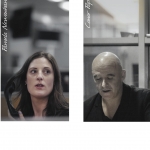The Irish Times: You Are What You Read
Owens DDB and PHD Ireland
Introduction & Background
Our advertising effectiveness journey begins in 2014, when The Irish Times conducted a competitive pitch for a new advertising agency. The intention was to respond to the declining newspaper market. The newspaper market had seen significant demise since the recession hit in 2008.
By 2014, Ireland’s newspaper market is declining at rate of -6%, mirroring the same decline as the overall global newspaper market (measured in developed countries).
Newspaper sales in Ireland have been in retreat since 2007. In the second half of 2007, an average of 816,031 daily newspapers were sold each day; by the second half of 2015, that number stood at 478,115.
It’s worth noting at this stage that newspaper sales and readership are measured biannually. Sales (ABC figures) and readership (JNRS figures) are measured in daily titles and Sunday titles. The Irish Times is a daily title and this case study reflects this.
The 2014 newspaper market was challenged by a range of issues:
- Newspaper sales were in decline.
- Newspaper readership was in decline.
- The product (journalism) was being diluted by the amount of free news and entertainment sources available online.
- No Irish newspaper had successfully cracked how to charge for digital access.
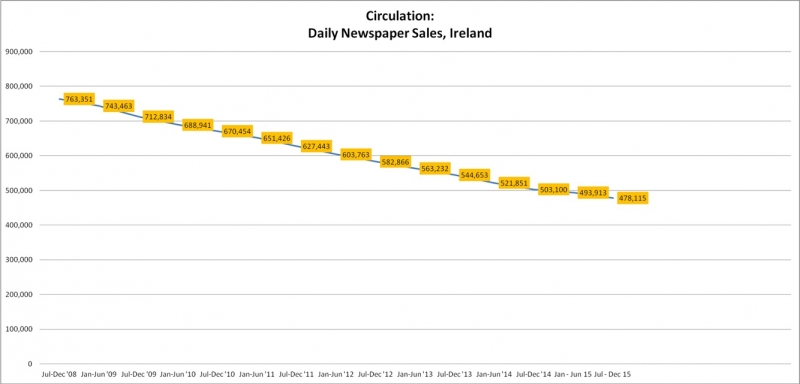
The impact of reduced disposable income for discretionary items like newspapers, coupled with the increased availability of free news on smartphones, has contributed to the dramatic decline.
There was a new normal by 2014. Irish society had changed and newspapers were feeling the pain, especially daily newspapers.
A recent a Behaviour & Attitudes survey ‘Connected Living’ confirmed this. By November 2015 70% of the population of Ireland carried a smartphone device. This means 2.37million Irish people use smartphones, which is up from 39% of the population using smartphones in 2012.
Marketing Objectives
With the newspaper market in Ireland declining at a rate of -6%, it was imperative to invest in communications, specifically brand communications.
With this new appetite for change, The Irish Times embarked on a competitive pitching process, appointing Owens DDB in October 2014.
The advertising had to work hard, so many strong objectives were set out in the brief.
Business Objectives:
- Halt decline of sales and readership.
- Grow readership and revenue (in print and online).
- Make The Irish Times a compelling choice for advertisers.
Communication Objective:
- To position The Irish Times as a trusted source of news, comment and analysis.
- To retain existing readers and maximise their engagement.
These objectives had to be obtained through a creative campaign that cut through with the Irish market.
The Task
The Irish Times is a well-established news organisation with a 157-year presence in Ireland. It was an exciting time to work on a new campaign; however, there were many elements to be conscious of. The communications had to express our belief in the great brand and quality journalism and at the same time be extremely careful not to sound condescending or elitist. It was a balance that would live or die in the tone of the communications.
Another consideration is that The Irish Times will never appeal to a large cohort of Irish people. There was no point to trying to convince people to read The Irish Times who have zero interest in broadsheet newspapers. The challenge was to increase sales and readership while fishing in a limited pool.
Halt decline
The ABC circulation graph looks like a slope. Year-on-year, the sales were significantly down. This was indicative of the market both in Ireland and the developed world.
Avoiding Price Reduction
Our biggest competitor, The Irish Independent, was participating in a discounting scheme with Tesco. We chose to avoid this by investing in marketing and advertising for business and brand reasons.
Introduce a paywall in 2015
This was a huge challenge. Introducing a paywall for our digital content into a world where consumers were used to free news.
The brand campaign had to work extremely hard to demonstrate that The Irish Times is worth paying for. Not just worth paying for the newspaper, but also for previously free access (digital).
The paywall allowed readers to view 10 articles on the site or 20 articles on the mobile app per week before they are charged for more (unlimited) access.
The entry-level charge was €12 per month for a subscription.
Increase Readership
There are two ways a newspaper organisation can make money. The first is newspaper sales and the second is media sales (selling advertising space). The first is achieved through circulation and measured by ABC, the second is achieved through readership and measured by JNRS and website traffic.
Where many businesses talk about ‘bums on seats’, our objective was ‘eyes reading articles’ – in print and online. Increased readership would increase sales and increase profit through advertising readership.
We needed to shake up what we were saying and took the bold step to move away from the historical ‘For The Times We Live In’ tagline, and offer a fresh approach to the new world the news organisation was competing in.
The tasks were tough and the market was unforgiving, so the communications needed to work extremely hard. The Irish Times had provided the advertising brief, but there was an opportunity to work with a blank canvas to create something interesting with creative standout.
The Strategy
It was important for consumers to perceive that The Irish Times is something worth paying for (in print and eventually online). In a world of free news and entertainment, the strategy was to elevate the brand.
You’re not just reading the news. You’re reading the news as brought to you by an Irish Times journalist.
What consumers were really paying for when they purchased The Irish Times was the environment of editorial integrity in which the journalists work. You could trust the source and quote the article with confidence.
Our writers set us apart. And it was this insight that led to the creation of the new proposition.
Creative Strategy
Our strategy was to hero the journalists. Make them the stars. Make them our selling point and celebrate their differentiating factors.
We planned to put a face to the words. Introducing the journalists to the Irish public and making them seem more accessible. Watching them on TV. Seeing them in print. Reading their throwaway comments on Twitter. All this differentiated us, and the approach would build rapport with the readers.
The process involved selecting journalists from a variety of backgrounds. We interviewed each journalist to discover their interests, passions, and to find out why they do what they do. On the day of the shoot, the journalists spoke candidly about their job as we filmed them. None of the footage was scripted. It had to be authentic and this authenticity made the videos convincing and real.
Through presenting the journalists as people of integrity, conviction and talent, we differentiated The Irish Times’ offering from its competitors. With such fantastic writers, we made a convincing case to consumers that The Irish Times was worth paying for, both in hard copy and in digital format.
A new brand line was launched that underpinned all of this:

This comes from the familiar saying, ‘you are what you eat’. And what that really means is that your health and well-being are dictated by what you consume.
Your understanding of the issues of the day – be it in sport, current affairs, business or entertainment – is also dictated by what you consume. And if you consume The Irish Times you’ll find yourself extremely well-informed, thanks to the quality of the journalism and the quality of the writers who provide it.
This approach challenged the consumer. What are you feeding your brain? If you want to understand what’s going on in your world and have an opinion on it, consider reading The Irish Times.
This campaign involved a new strategy, a new proposition, a new tag line and a creative brand campaign that was flexible enough to employ tactical messaging if needed.
It was also important that this new positioning was robust enough to carry the weight of the upcoming digital paywall introduction.
Use of channels
The creative concept shaped the media plan. Through leading with 3-minute documentaries rather than traditional TV ads, media selection focused initially on online channels and social media.
This was supported by TV, VOD, radio, outdoor, cinema and print.
The long-format documentaries were housed on a landing page created for the ‘You Are What You Read’ campaign. http://www.irishtimes.com/you-are-what-you-read
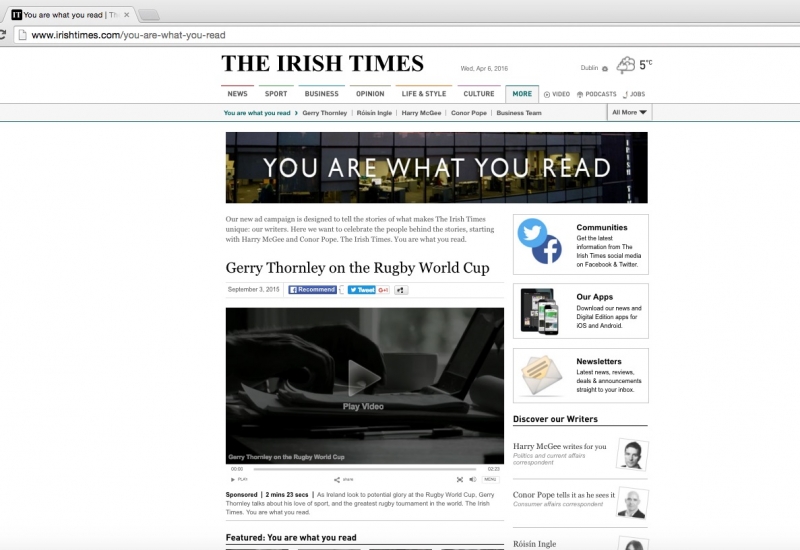
The Idea
There were three pillars to the campaign:
- Brand
- Tactical/Content
- Digital subscriptions
1. Brand
The brand campaign ran on TV, VOD, radio, outdoor, digital display, social media, cinema, and print.
What was different about this campaign was the use of long-format documentaries to launch it. The longer format gave the consumers the opportunity to get a really good sense of the journalists and understand what makes them tick. This is something we couldn’t have achieved had we led with 30-second TV spots.
Also, by leading with creative that lived online, we firmly positioned The Irish Times as a player in the digital arena; an arena where many of the big battles for traditional media organisations are taking place.
‘You Are What You Read’ was the beginning of a new identity for the Irish Times brand. There was no new news to communicate. So the brand element was the most important pillar in the communications. It was imperative to demonstrate the strengths and accessibility of the brand and to remind consumers what a great product and brand The Irish Times was.
The mini-documentaries featured on the Irish Times website were as follows:
‘Harry McGee writes for you.’
(3’58”) Politics and current affairs are at the heart of The Irish Times’ coverage. Find out what makes political correspondent Harry McGee tick and how his role has changed in the age of new technology. The Irish Times. You Are What You Read.
‘Róisín Ingle. Making the ordinary extraordinary.’
(2’47”) Róisín Ingle writes about the things that speak to her. She takes the ordinary and makes it extraordinary. Find out how and why in her mini-documentary. The Irish Times. You Are What You Read.
‘Keith Duggan gets behind the story.’
(3’43”) ‘Sport has a way of conferring immortality on its participants. The Irish Times’ chief sportswriter Keith Duggan gets behind the story of momentous days in sport. Find out why. The Irish Times. You Are What You Read.
‘Gerry Thornley on the Rugby World Cup.’
(2’23”) As Ireland look to potential glory at the Rugby World Cup, Gerry Thornley talks about his love of sport, and the greatest rugby tournament in the world. The Irish Times. You Are What You Read.
The 30-second cut-downs, which appeared on TV as well as online, also featured a variety of journalists:
Harry McGee – Politics
Róisín Ingle – Features
Ciarán Hancock – Business
Conor Pope – Consumer Affairs
Keith Duggan – Sport (GAA)
Gerry Thornley – Sport (Rugby World Cup)
Below are some examples of the 30second cut downs which ran on TV, VOD and digital dispaly:
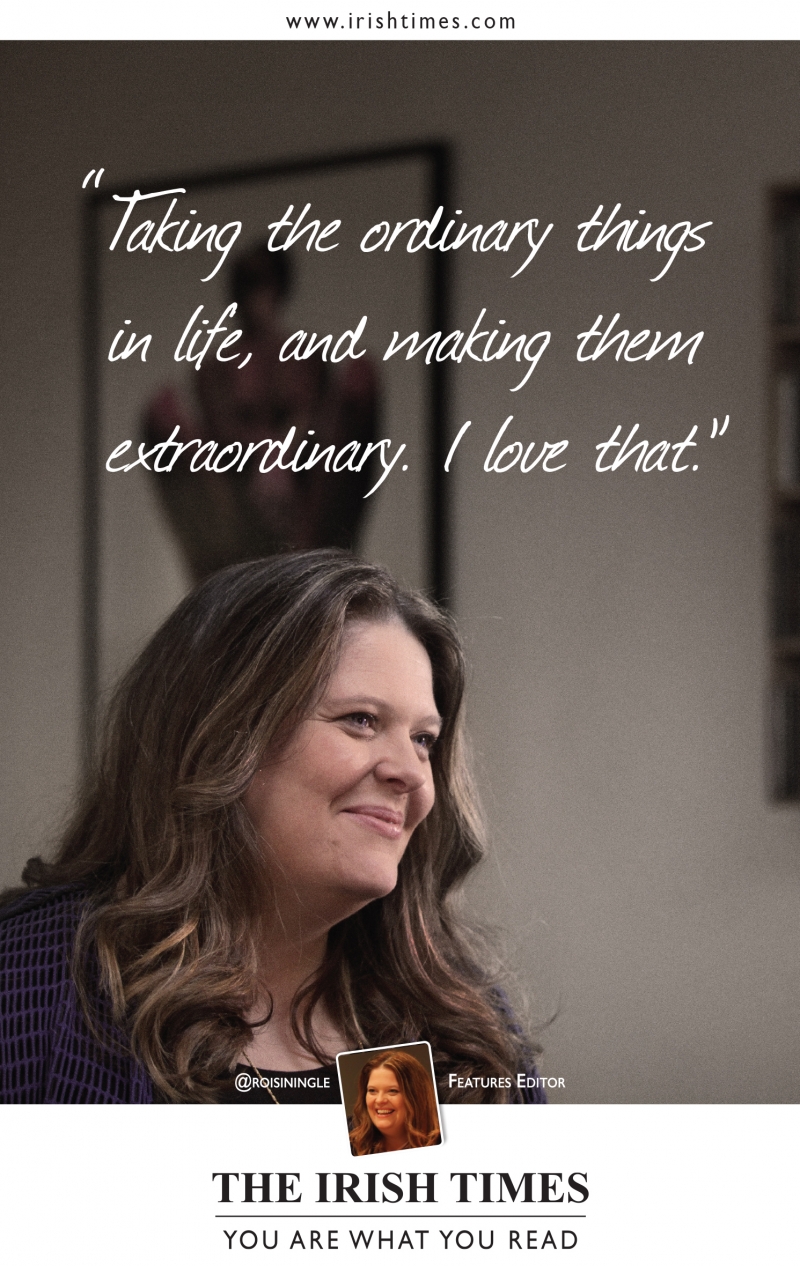
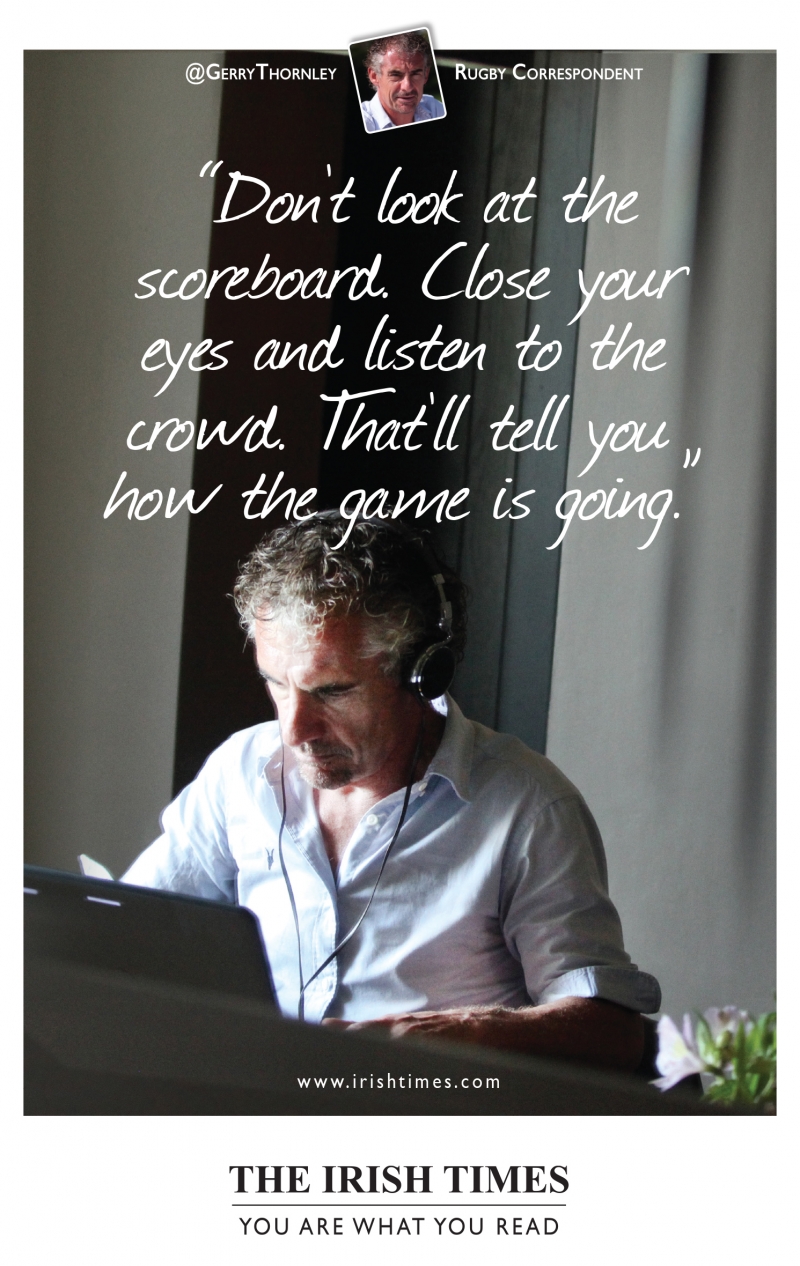
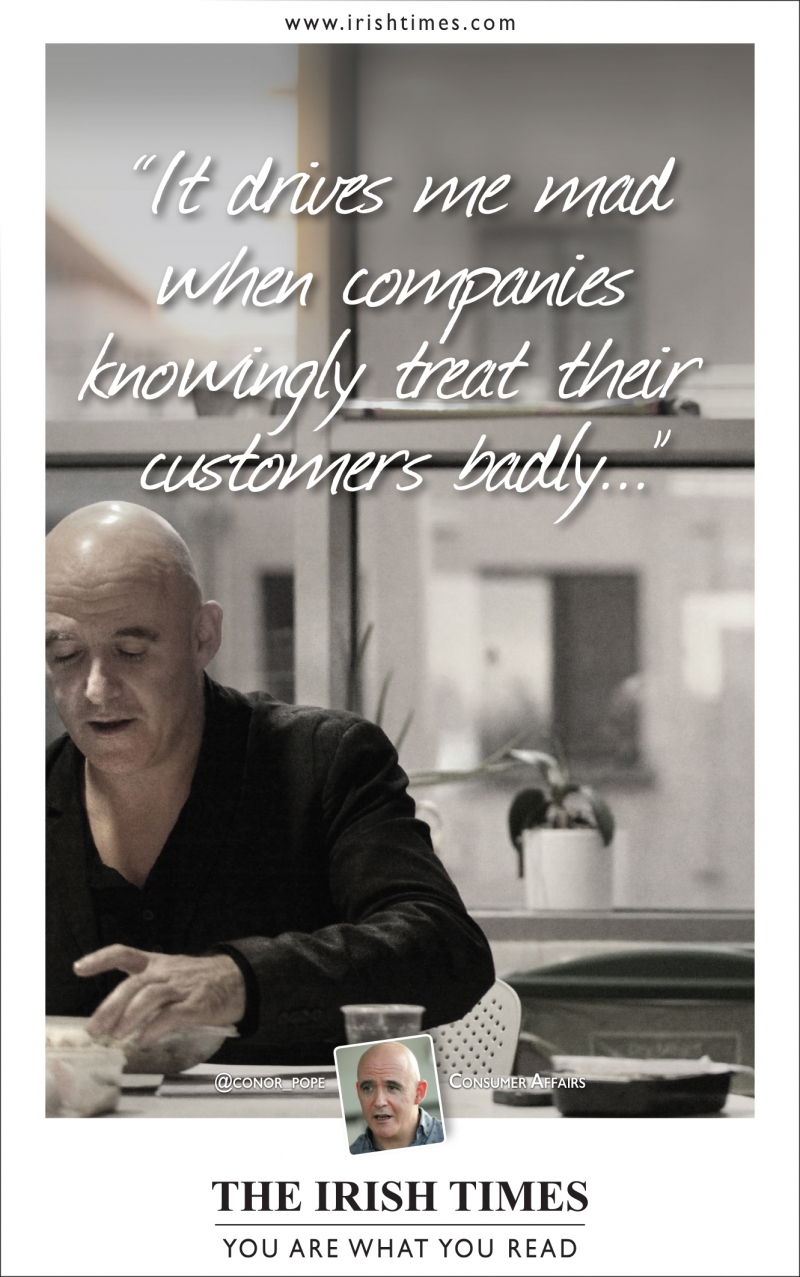
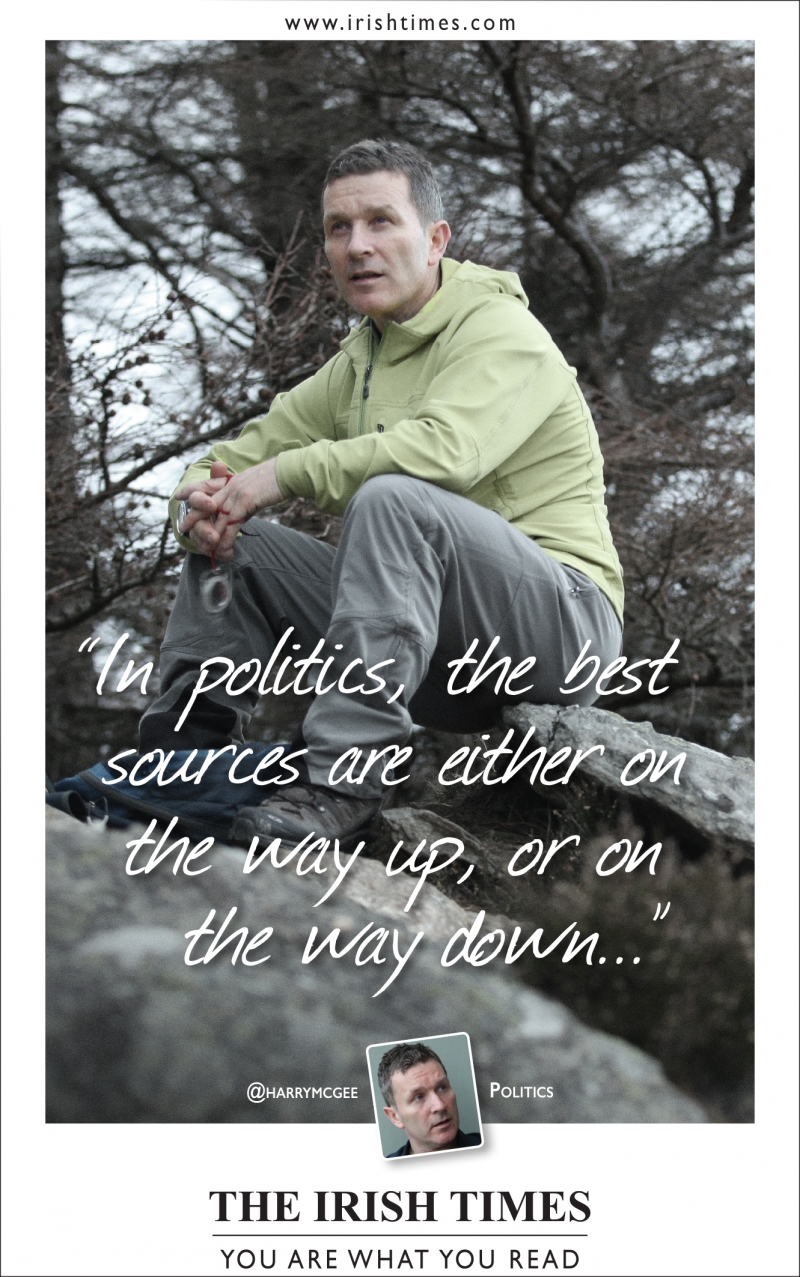


2. Tactical/content
The world of any media organisation is fast-paced and constantly changing, often with little or no warning.
The ability to respond to breaking or evolving stories is crucial.
We created radio templates that can be turned around in a matter of hours to advertise emerging stories The Irish Times wanted highlighted. Typically we produce 3 to 4 of these a week, almost always at very short notice.
A brand radio ad titled ‘Own Saturday’ was created that could run as brand and could be amended to become tactical and advertise forthcoming content for The Irish Times Weekend Edition. Both the brand and tactical versions of this ad tapped into the Irish zeitgeist of what Saturday means to our readers, and then demonstrated the intrinsic role The Irish Times plays in that Saturday.

For the general election campaign, we wanted to demonstrate that The Irish Times’ political coverage was second to none.
The ads that featured the 4 leaders running for election were placed in print, outdoor, and had support of tactical general election/political radio.
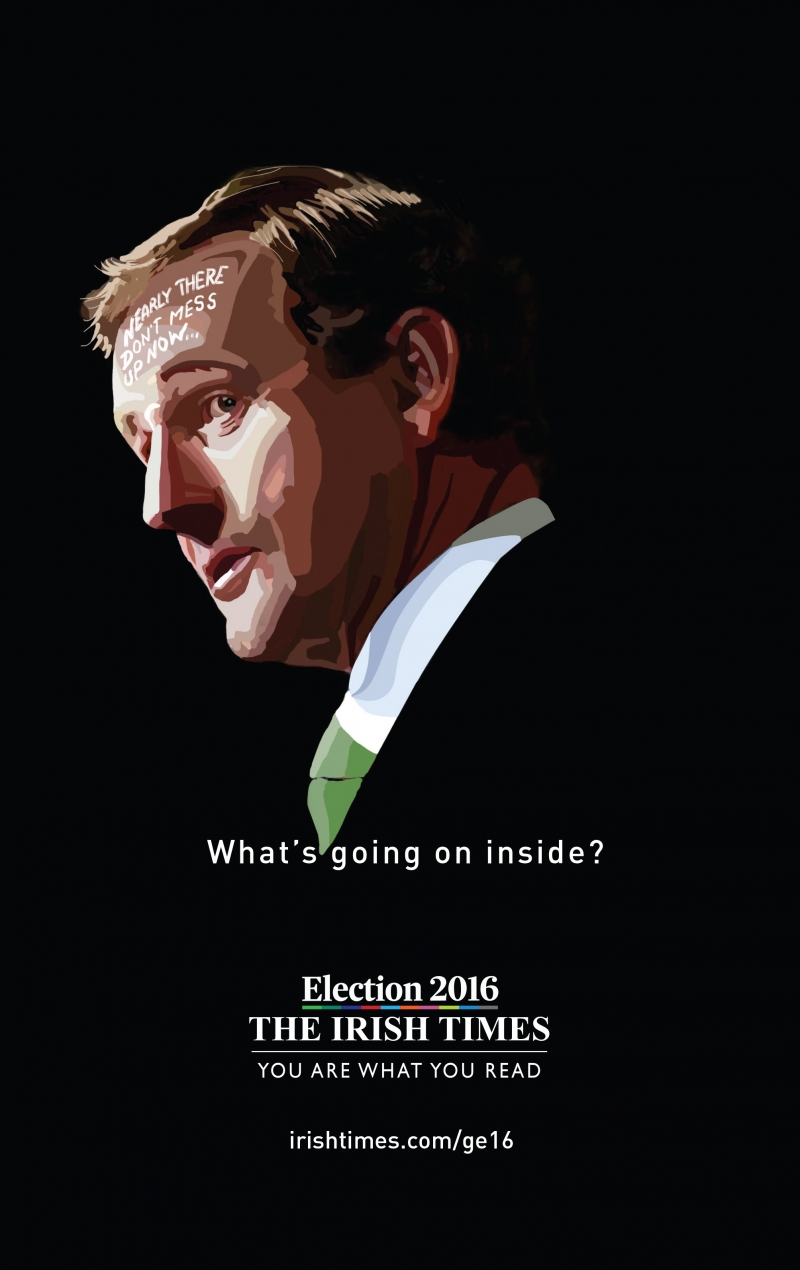
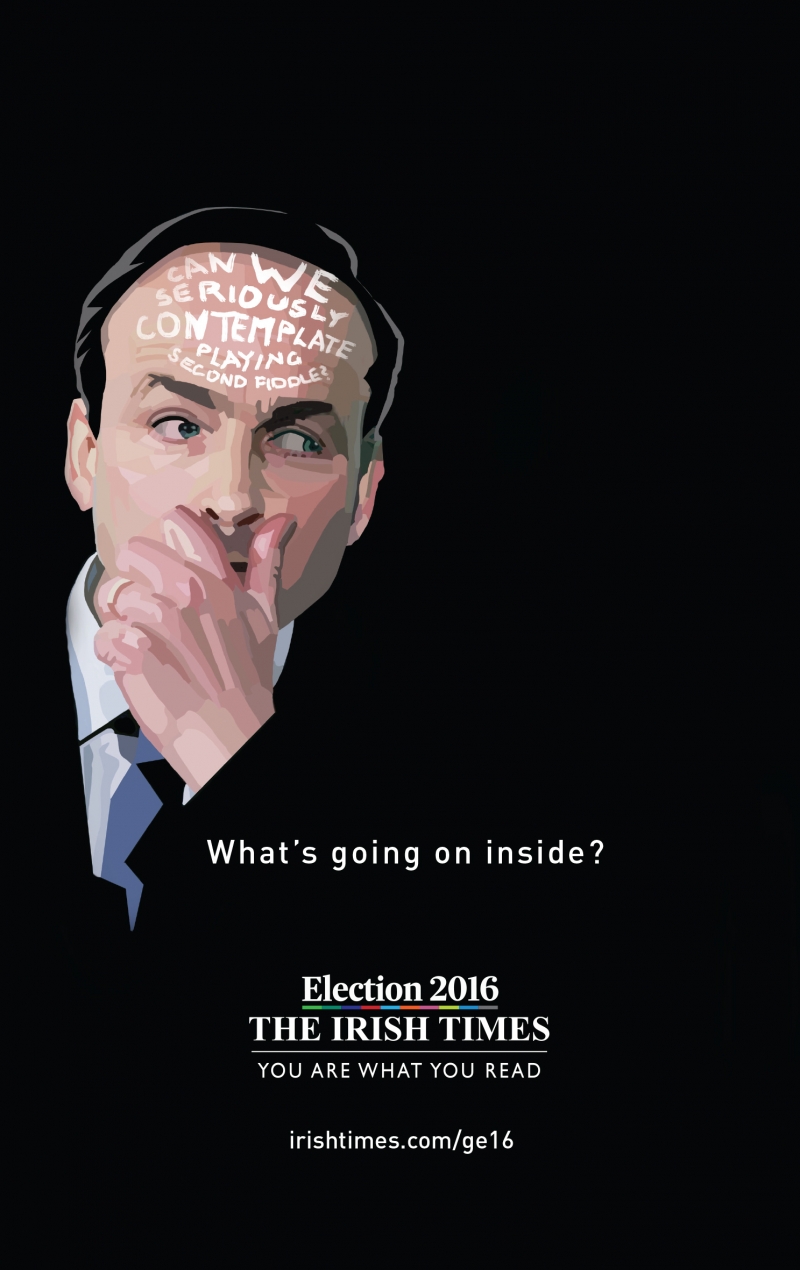

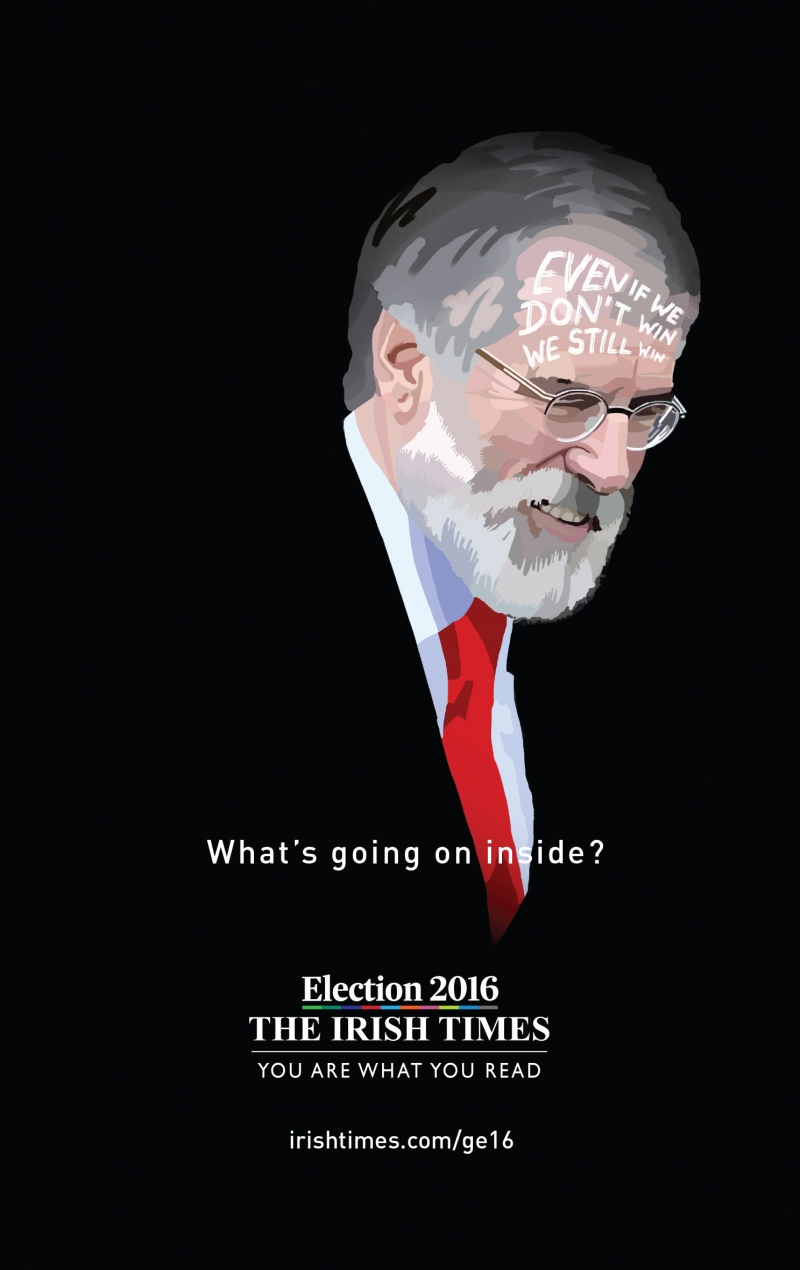
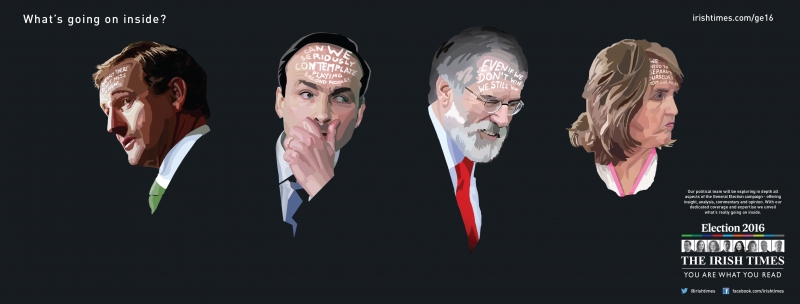
3. Digital subscriptions
Part of The Irish Times’ strategy for 2015 was the introduction of a paywall for digital content.
No daily news organisation (including ourselves) had successfully introduced anything like this before.
The brand campaign ‘You Are What You Read’ was a strong platform to communicate the new paywall, which would cost €12 per month at entry level.
The launch creative broke down the €12 into daily costs, and demonstrated the unlimited access and benefits to subscribing.
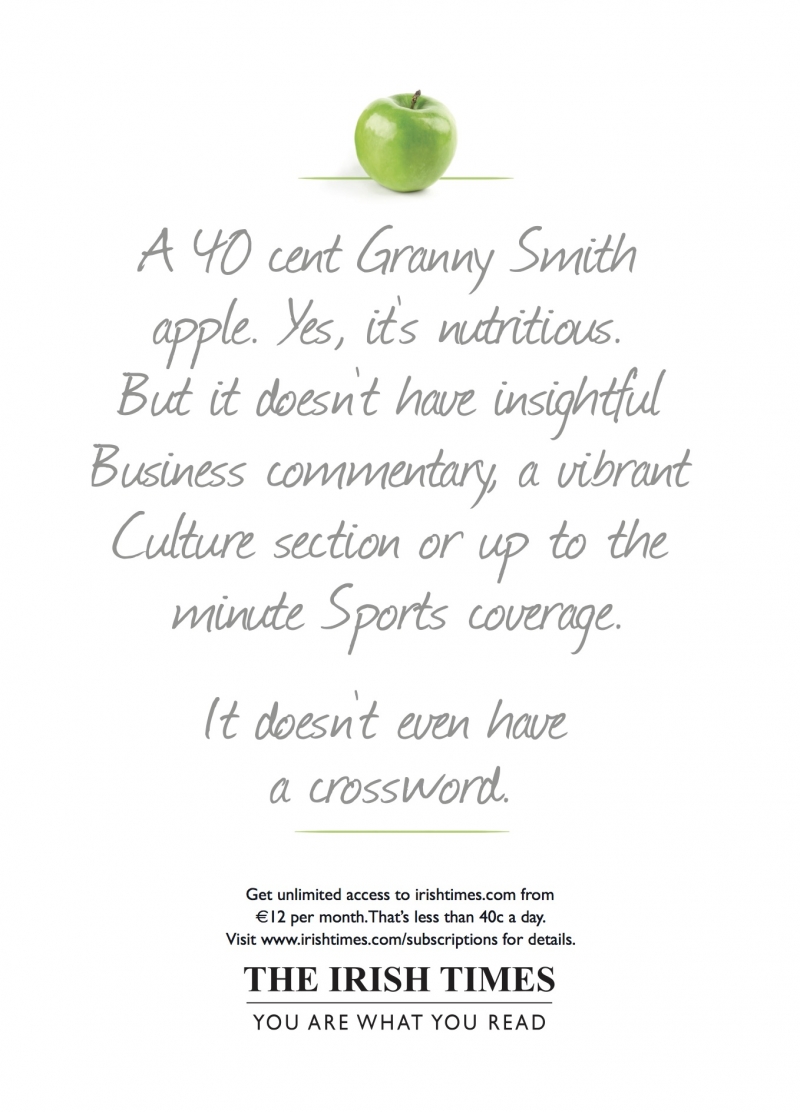
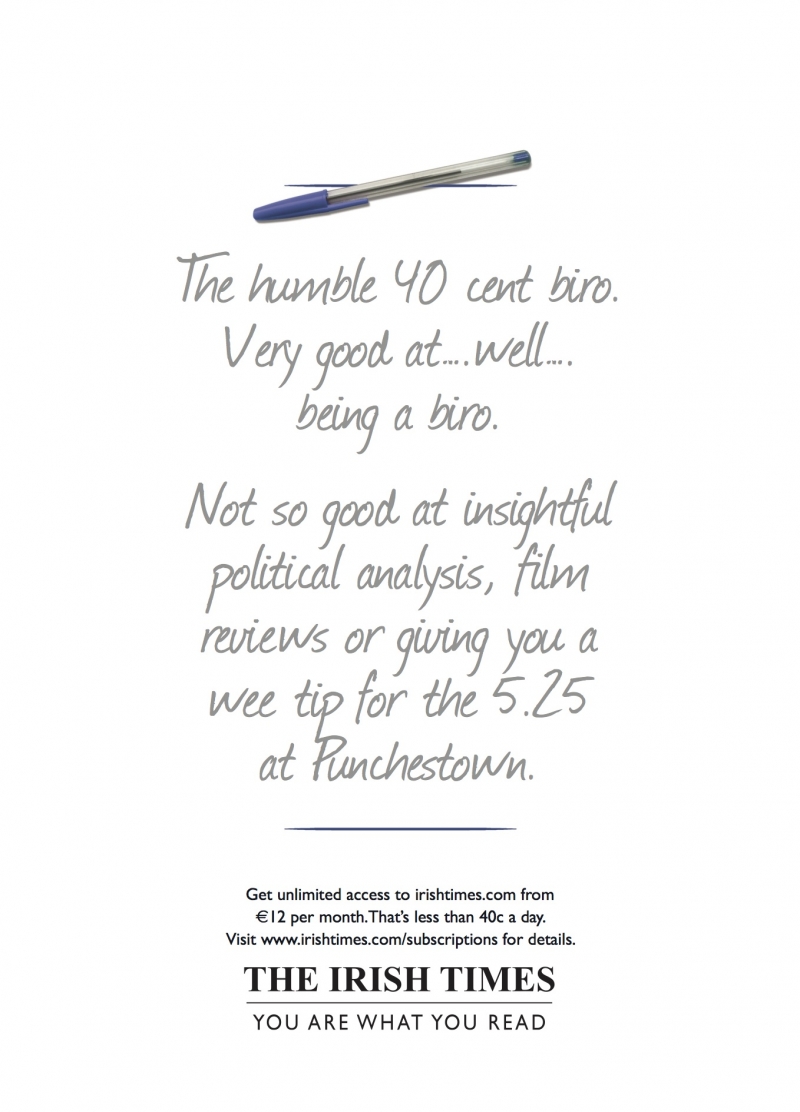
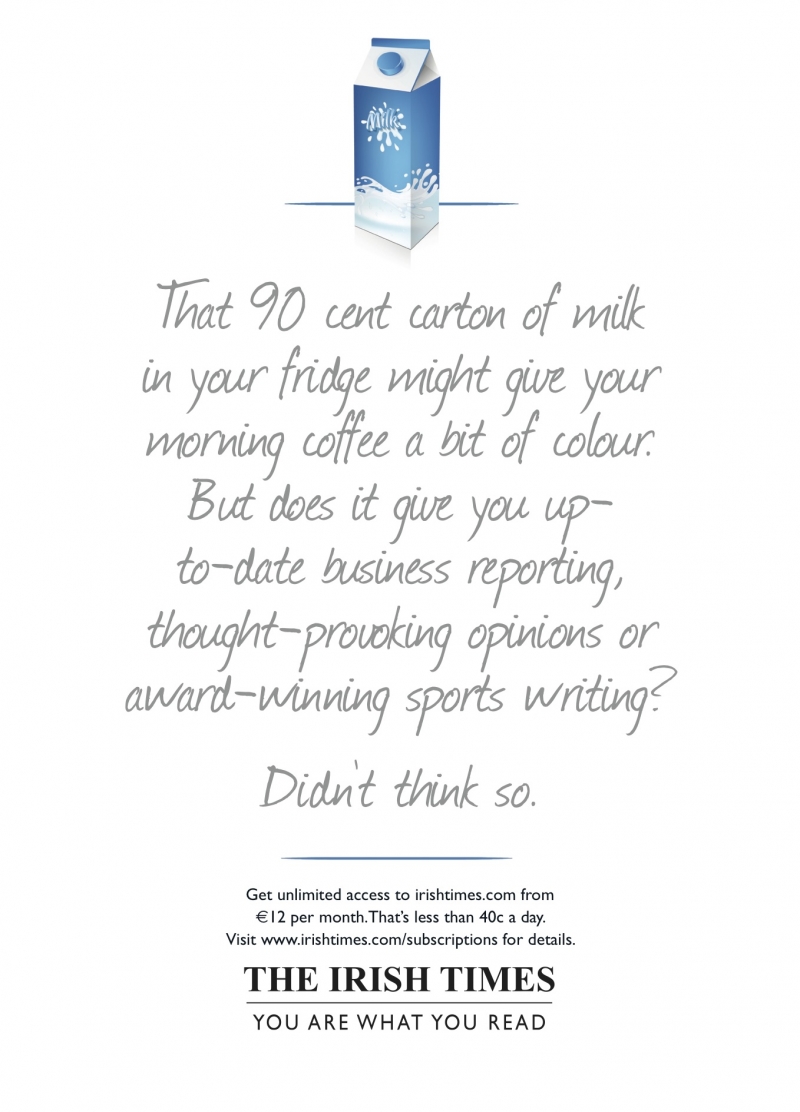
The Results
The campaign launched in January 2015 and we’ve seen exciting results. We have achieved our objectives and anecdotally are hearing really positive reviews of the campaign from consumers and all levels of staff in the Irish Times offices. The campaign has been deemed a success.
However, anecdotal evidence is no good for proving advertising effectiveness, so below are the actual figures.
Business Objectives:
- Halt decline of sales.
- Grow readership and revenue (in print and online).
- Make The Irish Times a compelling choice for advertisers.
(1.) Halt the decline of sales
In 2014, The Irish Times print edition was experiencing a decline in sales of -6%.
Our first business objective was to halt this slide. And by 2015, that -6% figure had reduced to -3.6%. This was against an overall market decline of -4.2% for 2015.
(2) Grow readership and revenue (in print and online).
JNRS results demonstrate that The Irish Times is growing readership. The average daily readership is up 10% year on year. This is the second highest daily reach of all Irish daily titles.
There has been an increase of 39,000 readers in print and online combined in 2015.
The Irish Times now engages with:
- 427,000 total daily readers across print and online (up +9%).
- +39,000 in past year.
- 317,000 Irish adults read The Irish Times in print (up +5%).
- +16,000 in past year.
- 159,000 consume The Irish Times content online on an average day (up +15%).
- +23,000 in past year.
- 802,000 total weekly readers: our highest ‘total weekly audience’ figure to date.
- +32,000 total growth in past year.
We have also increased our weekly reach: 22% of the population now read The Irish Times in print or online each week.
The Irish Times has the highest year on year cumulative audience growth of all daily-published Irish news titles.
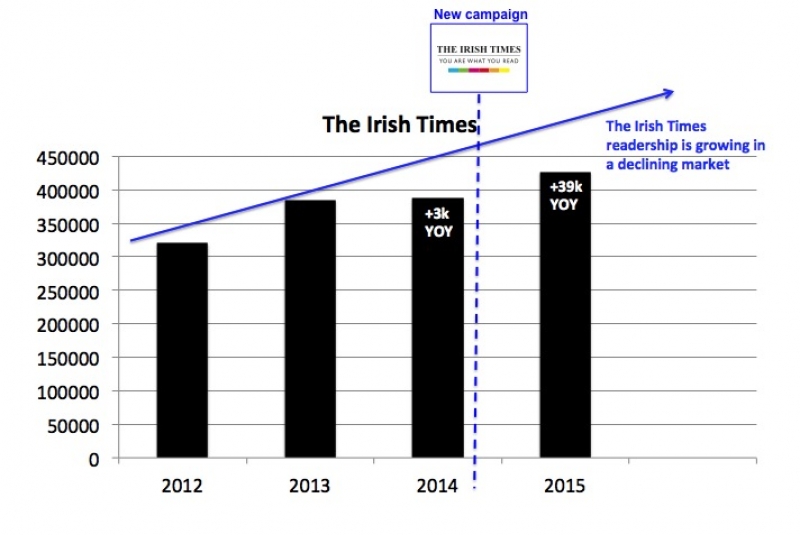
JNRS figures are based on the “average issue readership” of print newspapers and their websites, which is defined as “read yesterday” in the case of daily titles.

*2015/16 are the most recent JNRS results; however, at the time of submission, the results were not yet released. They have been delayed to check the 2015/16 methodology.
Due to confidentiality, we cannot detail revenue results. However, the increase in readership makes The Irish Times a compelling choice for many advertisers, which in turn generates increased revenue.
(3.) Make The Irish Times a compelling choice for advertisers.
Between 2014 and 2015, The JNRS shows a report on report increase of 23% in Irish adults using irishtimes.com in an average week.
As of February 2016, The Irish Times’ overall subscriber base had risen to 40,000, including subscribers to digital, print and bundle packages.
ABC Results
Combined sales for the print and digital editions (ePaper) of The Irish Times is 81,599, up 2.2% year-onyear.
The Irish Times ePaper has ABC-certified daily sales of 7,507 for 2015, compared to 2,951 in the second half of 2014, an increase of 154% (ABC July-December 2015 Report), which is a significant achievement at a time when one of our major competitors was engaged in a very aggressive price promotion at retail level.
Communications Objective 1: To position The Irish Times as a trusted source of news, comment and analysis.
In 2015, The Irish Times took part in INMA’s “Trust and Value in Newsmedia” survey. This collaborative survey by INMA’s European newsmedia members gathered readers’ opinions across eight European countries, with 115 newsbrands taking part. The Irish Times’ newspaper’s Net Promoter Score was revealed to be +25, in comparison with the European NPS benchmark of -5.
(Source: INMA Trust and Value in Newsmedia Survey 2015)
Communications Objective 2: To retain existing readers and maximize their engagement.
The research department in The Irish Times conducted a readers survey to test ‘You Are What You Read’ in February 2016. The Irish Times operates an audience panel to test effectiveness of commercial and editorial content appearing in print and online. Run in conjunction with their business partner, RAM Panel, they can:
- test advertising effectiveness;
- test audience response to multimedia campaigns;
- test editorial content; and
- solicit “open feedback” – similar to a large-scale ‘focus group’.
To test The Irish Times readers’ engagement with the ‘You Are What You Read’ campaign, we sent our audience panel a bespoke survey. Response was 419, of which 260 had noticed the campaign over the past year. Results are weighted against Daily Total Audience estimates for The Irish Times of 427,000 readers per day.
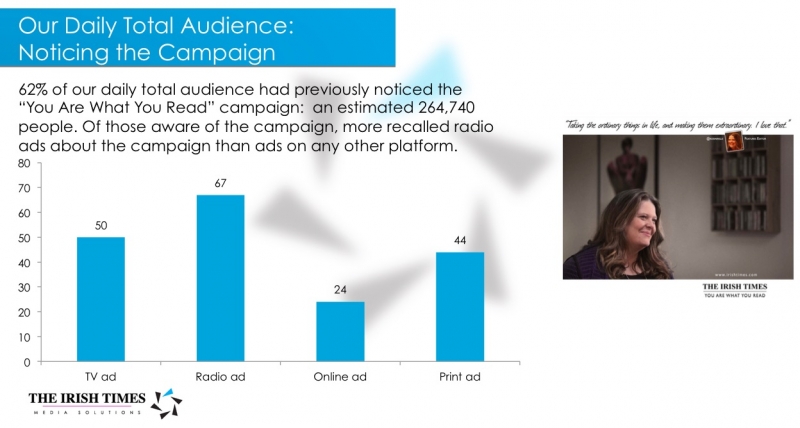
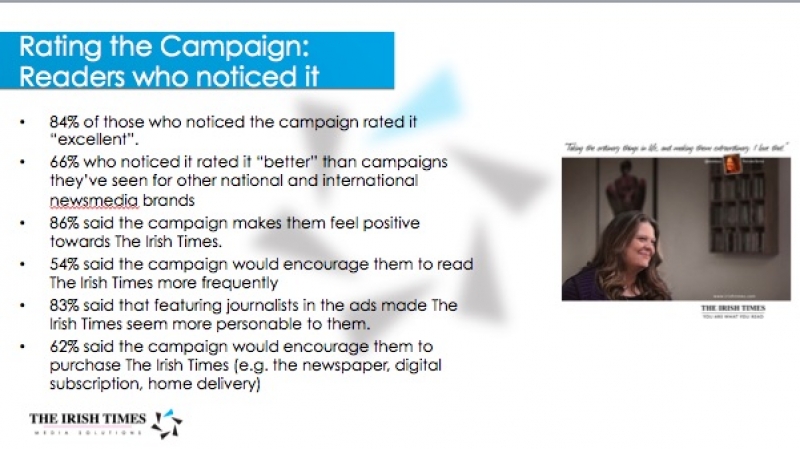
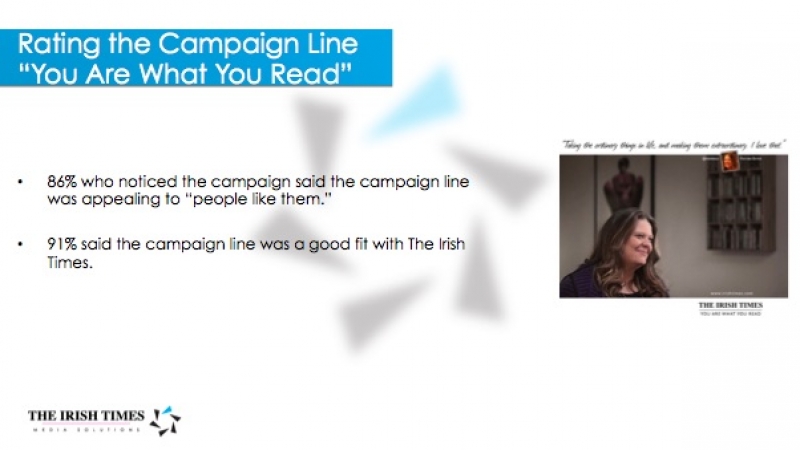


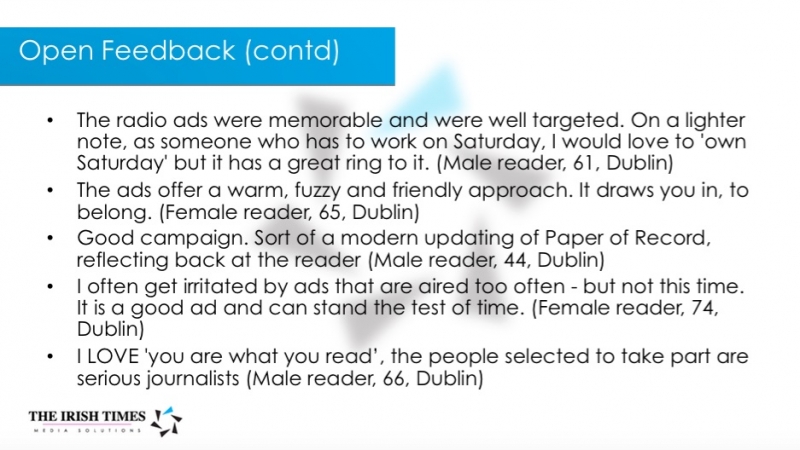
Discounting Factors:
- The market for print newspaper sales was in decline before and during the campaign, and is currently still in decline.
- We introduced a paywall for digital content during the campaign, while competitor titles still allowed unlimited access to their digital articles.
- There were key events during the campaign timings such as The Rugby World Cup, The General Election and 1916 celebrations; however, all these events were also covered/accessible to our competitors. We did not have monopoly on any key events or articles.
- 2015 was a year of investment in advertising and it was also the first year we witnessed growth. We attribute this growth to the effectiveness of the campaign.
Additional success: Grew frequency of online readership
Between 2014 and 2015, The JNRS shows a report on report increase of 23% in Irish adults using irishtimes.com in an average week.
(Source: JNRS/Millward Brown 13/14 and 14/15 reports).
Additional success: Grew readership in key segments
The Irish Times has the highest total audience in Dublin of any daily title, with 194,000 Dublin-based adults reading the title in print or online.
Some 80% of the print readership of The Irish Times belongs to the ABC1 social group that advertisers like to target.
The Impact
Our campaign engaged with consumers in a fresh and innovative way. The creative videos built a rapport between our USP (our writers) and the public. We didn’t say our writers had passion, we showed it.
The tone of this campaign also helped engage with readers. We stated who The Irish Times was with pride, not elitism.
This soft-sell approach and video-led strategy is a new direction for a brand that is so heavily entrenched in print. The obvious media plan would be to do a press and digital campaign, areas where our product lives.
Yet the online video and TV approach has paid dividends. The JNRS, ABC and reader research panel are demonstrating that this journalist-led campaign is working. The brand is now viewed as being more approachable. This all stemmed from a simple but effective creative idea that captured the public’s attention.
Behaviour was also changed when it came to charging for digital content. In a market where our competitors continue to give their online content away for free, we successfully persuaded 40,000 consumers to pay for ours.
This initiative could not and would not have been launched without the aid of a brand campaign.
New Learnings
- Creative Approach
We affirmed our belief that discounting isn't the only way to grow readership. We invested in communications and branding rather than getting involved in a race to the bottom.
We have started on a journey to remain premium while still accessible. This position will help us avoid implementing price decreases or engaging promotional activity to boost sales.
We learned that featuring the journalists in the communications has generated huge enthusiasm internally in The Irish Times. The journalists tend to be keen to get involved and are supportive of the approach. It also allowed us to demonstrate our strengths without being condescending or elitist.
- Mini-documentaries playing an important role
It is unusual to have documentaries as advertising, and the 3-minute videos played an important role in engaging with the public.
The videos were viewed online more than 1.2m times cumulatively.
More interestingly, 12,813 people actively clicked 'play' to watch the video on irishtimes.com. This figure does not include VOD where consumers must watch the video.
And 61,525 people visited the 'You Are What You Read' landing page to find out more.
- No script
None of the video or TV content was scripted. It was all the journalists' own words and thoughts and was a true and fair reflection of their lives and their job. This is rare for an advertising campaign. It was also brave, as the video element needed to be strong and emotive, which it was.
Summary
This case study details how the 2015 campaign ‘You Are What You Read’ has significantly increased readership (JNRS) and marginally increased sales (ABC) in a declining market. The proposition has brought new life to The Irish Times’ brand.
Average daily readership of The Irish Times is up +10% year on year.
This is the second highest daily reach of all Irish daily titles.
159,000 consume The Irish Times content online on an average day (up 15%).
The Irish Times is also proud to have 40,000 loyal readers who pay online subscriptions.
The campaign achieved all of the objectives set out at the start of the process, and is continuing to grow readership and sales and improve perceptions of the brand and the product.
Our advertising effectiveness journey begins in 2014, when The Irish Times conducted a competitive pitch for a new advertising agency. The intention was to respond to the declining newspaper market. The newspaper market had seen significant demise since the recession hit in 2008.
By 2014, Ireland’s newspaper market is declining at rate of -6%, mirroring the same decline as the overall global newspaper market (measured in developed countries).
Newspaper sales in Ireland have been in retreat since 2007. In the second half of 2007, an average of 816,031 daily newspapers were sold each day; by the second half of 2015, that number stood at 478,115.
It’s worth noting at this stage that newspaper sales and readership are measured biannually. Sales (ABC figures) and readership (JNRS figures) are measured in daily titles and Sunday titles. The Irish Times is a daily title and this case study reflects this.
The 2014 newspaper market was challenged by a range of issues:
- Newspaper sales were in decline.
- Newspaper readership was in decline.
- The product (journalism) was being diluted by the amount of free news and entertainment sources available online.
- No Irish newspaper had successfully cracked how to charge for digital access.

The impact of reduced disposable income for discretionary items like newspapers, coupled with the increased availability of free news on smartphones, has contributed to the dramatic decline.
There was a new normal by 2014. Irish society had changed and newspapers were feeling the pain, especially daily newspapers.
A recent a Behaviour & Attitudes survey ‘Connected Living’ confirmed this. By November 2015 70% of the population of Ireland carried a smartphone device. This means 2.37million Irish people use smartphones, which is up from 39% of the population using smartphones in 2012.
With the newspaper market in Ireland declining at a rate of -6%, it was imperative to invest in communications, specifically brand communications.
With this new appetite for change, The Irish Times embarked on a competitive pitching process, appointing Owens DDB in October 2014.
The advertising had to work hard, so many strong objectives were set out in the brief.
Business Objectives:
- Halt decline of sales and readership.
- Grow readership and revenue (in print and online).
- Make The Irish Times a compelling choice for advertisers.
Communication Objective:
- To position The Irish Times as a trusted source of news, comment and analysis.
- To retain existing readers and maximise their engagement.
These objectives had to be obtained through a creative campaign that cut through with the Irish market.
The Irish Times is a well-established news organisation with a 157-year presence in Ireland. It was an exciting time to work on a new campaign; however, there were many elements to be conscious of. The communications had to express our belief in the great brand and quality journalism and at the same time be extremely careful not to sound condescending or elitist. It was a balance that would live or die in the tone of the communications.
Another consideration is that The Irish Times will never appeal to a large cohort of Irish people. There was no point to trying to convince people to read The Irish Times who have zero interest in broadsheet newspapers. The challenge was to increase sales and readership while fishing in a limited pool.
Halt decline
The ABC circulation graph looks like a slope. Year-on-year, the sales were significantly down. This was indicative of the market both in Ireland and the developed world.
Avoiding Price Reduction
Our biggest competitor, The Irish Independent, was participating in a discounting scheme with Tesco. We chose to avoid this by investing in marketing and advertising for business and brand reasons.
Introduce a paywall in 2015
This was a huge challenge. Introducing a paywall for our digital content into a world where consumers were used to free news.
The brand campaign had to work extremely hard to demonstrate that The Irish Times is worth paying for. Not just worth paying for the newspaper, but also for previously free access (digital).
The paywall allowed readers to view 10 articles on the site or 20 articles on the mobile app per week before they are charged for more (unlimited) access.
The entry-level charge was €12 per month for a subscription.
Increase Readership
There are two ways a newspaper organisation can make money. The first is newspaper sales and the second is media sales (selling advertising space). The first is achieved through circulation and measured by ABC, the second is achieved through readership and measured by JNRS and website traffic.
Where many businesses talk about ‘bums on seats’, our objective was ‘eyes reading articles’ – in print and online. Increased readership would increase sales and increase profit through advertising readership.
We needed to shake up what we were saying and took the bold step to move away from the historical ‘For The Times We Live In’ tagline, and offer a fresh approach to the new world the news organisation was competing in.
The tasks were tough and the market was unforgiving, so the communications needed to work extremely hard. The Irish Times had provided the advertising brief, but there was an opportunity to work with a blank canvas to create something interesting with creative standout.
It was important for consumers to perceive that The Irish Times is something worth paying for (in print and eventually online). In a world of free news and entertainment, the strategy was to elevate the brand.
You’re not just reading the news. You’re reading the news as brought to you by an Irish Times journalist.
What consumers were really paying for when they purchased The Irish Times was the environment of editorial integrity in which the journalists work. You could trust the source and quote the article with confidence.
Our writers set us apart. And it was this insight that led to the creation of the new proposition.
Creative Strategy
Our strategy was to hero the journalists. Make them the stars. Make them our selling point and celebrate their differentiating factors.
We planned to put a face to the words. Introducing the journalists to the Irish public and making them seem more accessible. Watching them on TV. Seeing them in print. Reading their throwaway comments on Twitter. All this differentiated us, and the approach would build rapport with the readers.
The process involved selecting journalists from a variety of backgrounds. We interviewed each journalist to discover their interests, passions, and to find out why they do what they do. On the day of the shoot, the journalists spoke candidly about their job as we filmed them. None of the footage was scripted. It had to be authentic and this authenticity made the videos convincing and real.
Through presenting the journalists as people of integrity, conviction and talent, we differentiated The Irish Times’ offering from its competitors. With such fantastic writers, we made a convincing case to consumers that The Irish Times was worth paying for, both in hard copy and in digital format.
A new brand line was launched that underpinned all of this:

This comes from the familiar saying, ‘you are what you eat’. And what that really means is that your health and well-being are dictated by what you consume.
Your understanding of the issues of the day – be it in sport, current affairs, business or entertainment – is also dictated by what you consume. And if you consume The Irish Times you’ll find yourself extremely well-informed, thanks to the quality of the journalism and the quality of the writers who provide it.
This approach challenged the consumer. What are you feeding your brain? If you want to understand what’s going on in your world and have an opinion on it, consider reading The Irish Times.
This campaign involved a new strategy, a new proposition, a new tag line and a creative brand campaign that was flexible enough to employ tactical messaging if needed.
It was also important that this new positioning was robust enough to carry the weight of the upcoming digital paywall introduction.
Use of channels
The creative concept shaped the media plan. Through leading with 3-minute documentaries rather than traditional TV ads, media selection focused initially on online channels and social media.
This was supported by TV, VOD, radio, outdoor, cinema and print.
The long-format documentaries were housed on a landing page created for the ‘You Are What You Read’ campaign. http://www.irishtimes.com/you-are-what-you-read

There were three pillars to the campaign:
- Brand
- Tactical/Content
- Digital subscriptions
1. Brand
The brand campaign ran on TV, VOD, radio, outdoor, digital display, social media, cinema, and print.
What was different about this campaign was the use of long-format documentaries to launch it. The longer format gave the consumers the opportunity to get a really good sense of the journalists and understand what makes them tick. This is something we couldn’t have achieved had we led with 30-second TV spots.
Also, by leading with creative that lived online, we firmly positioned The Irish Times as a player in the digital arena; an arena where many of the big battles for traditional media organisations are taking place.
‘You Are What You Read’ was the beginning of a new identity for the Irish Times brand. There was no new news to communicate. So the brand element was the most important pillar in the communications. It was imperative to demonstrate the strengths and accessibility of the brand and to remind consumers what a great product and brand The Irish Times was.
The mini-documentaries featured on the Irish Times website were as follows:
‘Harry McGee writes for you.’
(3’58”) Politics and current affairs are at the heart of The Irish Times’ coverage. Find out what makes political correspondent Harry McGee tick and how his role has changed in the age of new technology. The Irish Times. You Are What You Read.
‘Róisín Ingle. Making the ordinary extraordinary.’
(2’47”) Róisín Ingle writes about the things that speak to her. She takes the ordinary and makes it extraordinary. Find out how and why in her mini-documentary. The Irish Times. You Are What You Read.
‘Keith Duggan gets behind the story.’
(3’43”) ‘Sport has a way of conferring immortality on its participants. The Irish Times’ chief sportswriter Keith Duggan gets behind the story of momentous days in sport. Find out why. The Irish Times. You Are What You Read.
‘Gerry Thornley on the Rugby World Cup.’
(2’23”) As Ireland look to potential glory at the Rugby World Cup, Gerry Thornley talks about his love of sport, and the greatest rugby tournament in the world. The Irish Times. You Are What You Read.
The 30-second cut-downs, which appeared on TV as well as online, also featured a variety of journalists:
Harry McGee – Politics
Róisín Ingle – Features
Ciarán Hancock – Business
Conor Pope – Consumer Affairs
Keith Duggan – Sport (GAA)
Gerry Thornley – Sport (Rugby World Cup)
Below are some examples of the 30second cut downs which ran on TV, VOD and digital dispaly:






2. Tactical/content
The world of any media organisation is fast-paced and constantly changing, often with little or no warning.
The ability to respond to breaking or evolving stories is crucial.
We created radio templates that can be turned around in a matter of hours to advertise emerging stories The Irish Times wanted highlighted. Typically we produce 3 to 4 of these a week, almost always at very short notice.
A brand radio ad titled ‘Own Saturday’ was created that could run as brand and could be amended to become tactical and advertise forthcoming content for The Irish Times Weekend Edition. Both the brand and tactical versions of this ad tapped into the Irish zeitgeist of what Saturday means to our readers, and then demonstrated the intrinsic role The Irish Times plays in that Saturday.

For the general election campaign, we wanted to demonstrate that The Irish Times’ political coverage was second to none.
The ads that featured the 4 leaders running for election were placed in print, outdoor, and had support of tactical general election/political radio.





3. Digital subscriptions
Part of The Irish Times’ strategy for 2015 was the introduction of a paywall for digital content.
No daily news organisation (including ourselves) had successfully introduced anything like this before.
The brand campaign ‘You Are What You Read’ was a strong platform to communicate the new paywall, which would cost €12 per month at entry level.
The launch creative broke down the €12 into daily costs, and demonstrated the unlimited access and benefits to subscribing.



The campaign launched in January 2015 and we’ve seen exciting results. We have achieved our objectives and anecdotally are hearing really positive reviews of the campaign from consumers and all levels of staff in the Irish Times offices. The campaign has been deemed a success.
However, anecdotal evidence is no good for proving advertising effectiveness, so below are the actual figures.
Business Objectives:
- Halt decline of sales.
- Grow readership and revenue (in print and online).
- Make The Irish Times a compelling choice for advertisers.
(1.) Halt the decline of sales
In 2014, The Irish Times print edition was experiencing a decline in sales of -6%.
Our first business objective was to halt this slide. And by 2015, that -6% figure had reduced to -3.6%. This was against an overall market decline of -4.2% for 2015.
(2) Grow readership and revenue (in print and online).
JNRS results demonstrate that The Irish Times is growing readership. The average daily readership is up 10% year on year. This is the second highest daily reach of all Irish daily titles.
There has been an increase of 39,000 readers in print and online combined in 2015.
The Irish Times now engages with:
- 427,000 total daily readers across print and online (up +9%).
- +39,000 in past year.
- 317,000 Irish adults read The Irish Times in print (up +5%).
- +16,000 in past year.
- 159,000 consume The Irish Times content online on an average day (up +15%).
- +23,000 in past year.
- 802,000 total weekly readers: our highest ‘total weekly audience’ figure to date.
- +32,000 total growth in past year.
We have also increased our weekly reach: 22% of the population now read The Irish Times in print or online each week.
The Irish Times has the highest year on year cumulative audience growth of all daily-published Irish news titles.

JNRS figures are based on the “average issue readership” of print newspapers and their websites, which is defined as “read yesterday” in the case of daily titles.

*2015/16 are the most recent JNRS results; however, at the time of submission, the results were not yet released. They have been delayed to check the 2015/16 methodology.
Due to confidentiality, we cannot detail revenue results. However, the increase in readership makes The Irish Times a compelling choice for many advertisers, which in turn generates increased revenue.
(3.) Make The Irish Times a compelling choice for advertisers.
Between 2014 and 2015, The JNRS shows a report on report increase of 23% in Irish adults using irishtimes.com in an average week.
As of February 2016, The Irish Times’ overall subscriber base had risen to 40,000, including subscribers to digital, print and bundle packages.
ABC Results
Combined sales for the print and digital editions (ePaper) of The Irish Times is 81,599, up 2.2% year-onyear.
The Irish Times ePaper has ABC-certified daily sales of 7,507 for 2015, compared to 2,951 in the second half of 2014, an increase of 154% (ABC July-December 2015 Report), which is a significant achievement at a time when one of our major competitors was engaged in a very aggressive price promotion at retail level.
Communications Objective 1: To position The Irish Times as a trusted source of news, comment and analysis.
In 2015, The Irish Times took part in INMA’s “Trust and Value in Newsmedia” survey. This collaborative survey by INMA’s European newsmedia members gathered readers’ opinions across eight European countries, with 115 newsbrands taking part. The Irish Times’ newspaper’s Net Promoter Score was revealed to be +25, in comparison with the European NPS benchmark of -5.
(Source: INMA Trust and Value in Newsmedia Survey 2015)
Communications Objective 2: To retain existing readers and maximize their engagement.
The research department in The Irish Times conducted a readers survey to test ‘You Are What You Read’ in February 2016. The Irish Times operates an audience panel to test effectiveness of commercial and editorial content appearing in print and online. Run in conjunction with their business partner, RAM Panel, they can:
- test advertising effectiveness;
- test audience response to multimedia campaigns;
- test editorial content; and
- solicit “open feedback” – similar to a large-scale ‘focus group’.
To test The Irish Times readers’ engagement with the ‘You Are What You Read’ campaign, we sent our audience panel a bespoke survey. Response was 419, of which 260 had noticed the campaign over the past year. Results are weighted against Daily Total Audience estimates for The Irish Times of 427,000 readers per day.






Discounting Factors:
- The market for print newspaper sales was in decline before and during the campaign, and is currently still in decline.
- We introduced a paywall for digital content during the campaign, while competitor titles still allowed unlimited access to their digital articles.
- There were key events during the campaign timings such as The Rugby World Cup, The General Election and 1916 celebrations; however, all these events were also covered/accessible to our competitors. We did not have monopoly on any key events or articles.
- 2015 was a year of investment in advertising and it was also the first year we witnessed growth. We attribute this growth to the effectiveness of the campaign.
Additional success: Grew frequency of online readership
Between 2014 and 2015, The JNRS shows a report on report increase of 23% in Irish adults using irishtimes.com in an average week.
(Source: JNRS/Millward Brown 13/14 and 14/15 reports).
Additional success: Grew readership in key segments
The Irish Times has the highest total audience in Dublin of any daily title, with 194,000 Dublin-based adults reading the title in print or online.
Some 80% of the print readership of The Irish Times belongs to the ABC1 social group that advertisers like to target.
Our campaign engaged with consumers in a fresh and innovative way. The creative videos built a rapport between our USP (our writers) and the public. We didn’t say our writers had passion, we showed it.
The tone of this campaign also helped engage with readers. We stated who The Irish Times was with pride, not elitism.
This soft-sell approach and video-led strategy is a new direction for a brand that is so heavily entrenched in print. The obvious media plan would be to do a press and digital campaign, areas where our product lives.
Yet the online video and TV approach has paid dividends. The JNRS, ABC and reader research panel are demonstrating that this journalist-led campaign is working. The brand is now viewed as being more approachable. This all stemmed from a simple but effective creative idea that captured the public’s attention.
Behaviour was also changed when it came to charging for digital content. In a market where our competitors continue to give their online content away for free, we successfully persuaded 40,000 consumers to pay for ours.
This initiative could not and would not have been launched without the aid of a brand campaign.
- Creative Approach
We affirmed our belief that discounting isn't the only way to grow readership. We invested in communications and branding rather than getting involved in a race to the bottom.
We have started on a journey to remain premium while still accessible. This position will help us avoid implementing price decreases or engaging promotional activity to boost sales.
We learned that featuring the journalists in the communications has generated huge enthusiasm internally in The Irish Times. The journalists tend to be keen to get involved and are supportive of the approach. It also allowed us to demonstrate our strengths without being condescending or elitist.
- Mini-documentaries playing an important role
It is unusual to have documentaries as advertising, and the 3-minute videos played an important role in engaging with the public.
The videos were viewed online more than 1.2m times cumulatively.
More interestingly, 12,813 people actively clicked 'play' to watch the video on irishtimes.com. This figure does not include VOD where consumers must watch the video.
And 61,525 people visited the 'You Are What You Read' landing page to find out more.
- No script
None of the video or TV content was scripted. It was all the journalists' own words and thoughts and was a true and fair reflection of their lives and their job. This is rare for an advertising campaign. It was also brave, as the video element needed to be strong and emotive, which it was.
This case study details how the 2015 campaign ‘You Are What You Read’ has significantly increased readership (JNRS) and marginally increased sales (ABC) in a declining market. The proposition has brought new life to The Irish Times’ brand.
Average daily readership of The Irish Times is up +10% year on year.
This is the second highest daily reach of all Irish daily titles.
159,000 consume The Irish Times content online on an average day (up 15%).
The Irish Times is also proud to have 40,000 loyal readers who pay online subscriptions.
The campaign achieved all of the objectives set out at the start of the process, and is continuing to grow readership and sales and improve perceptions of the brand and the product.






